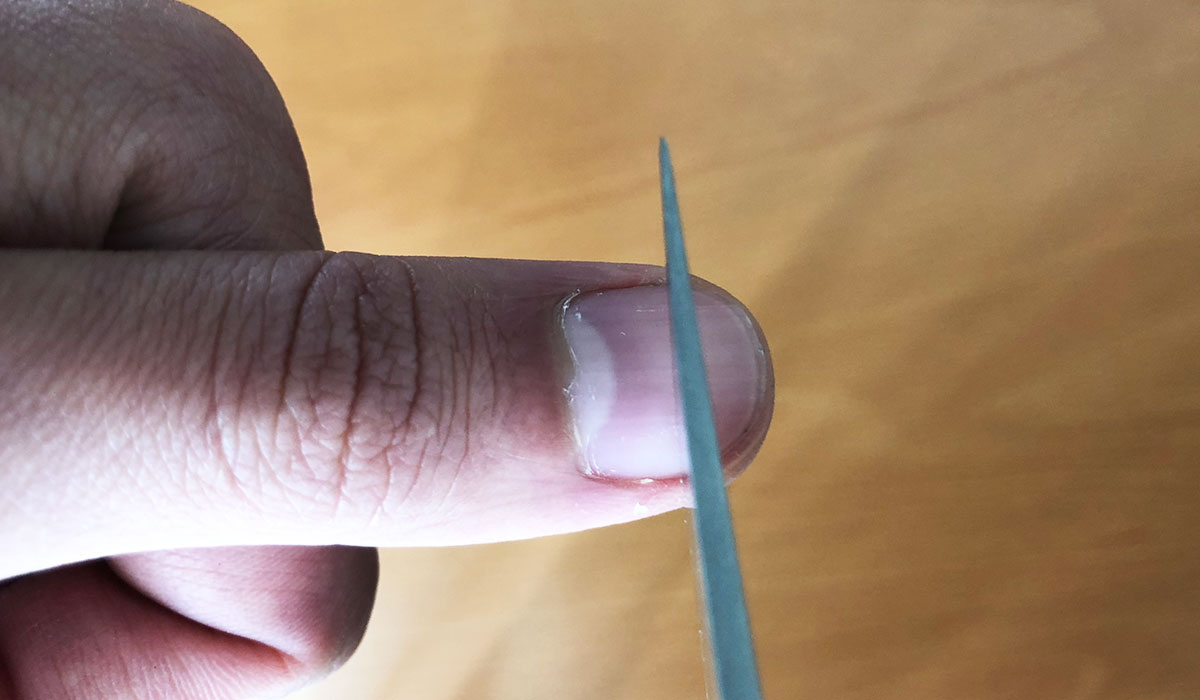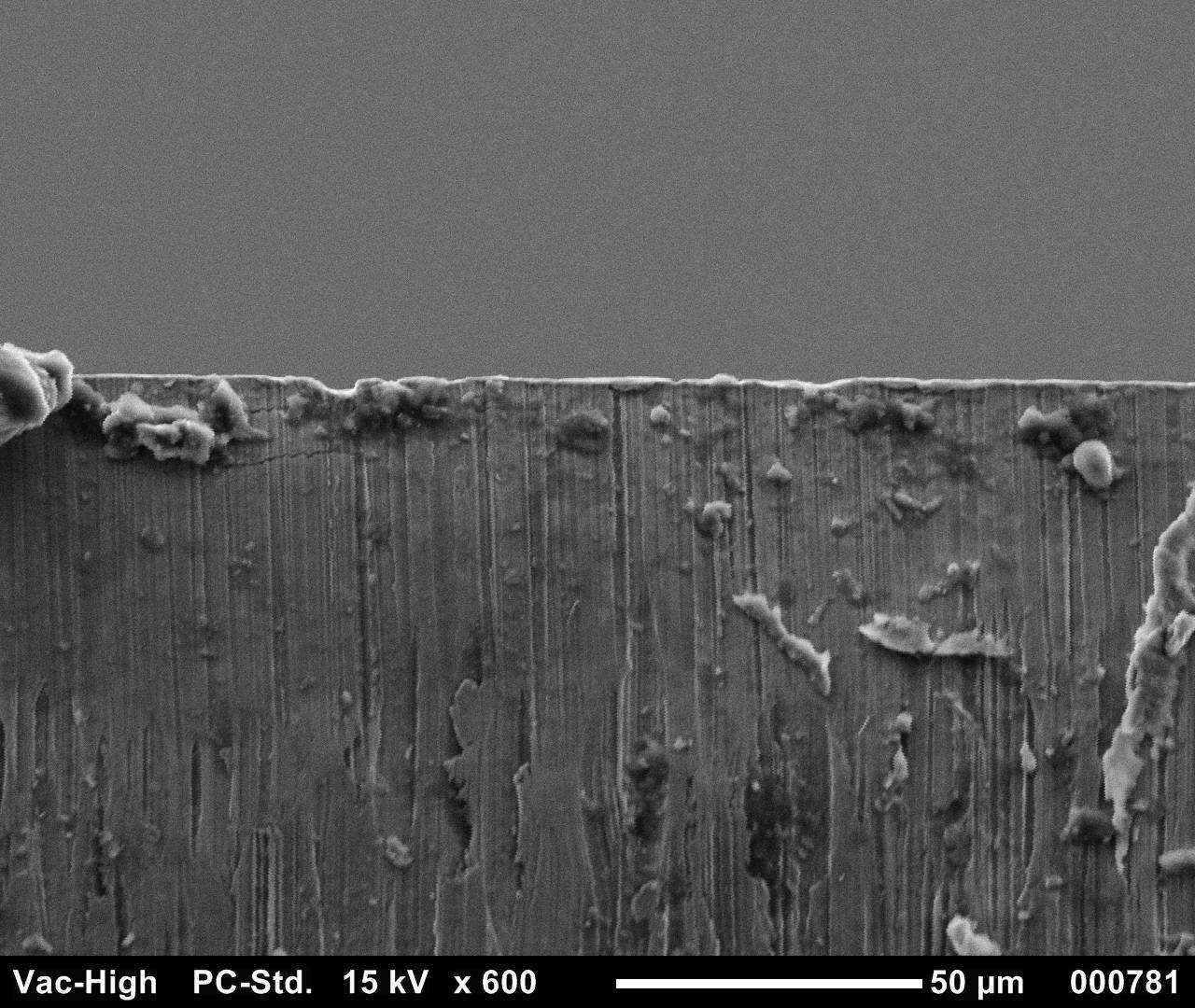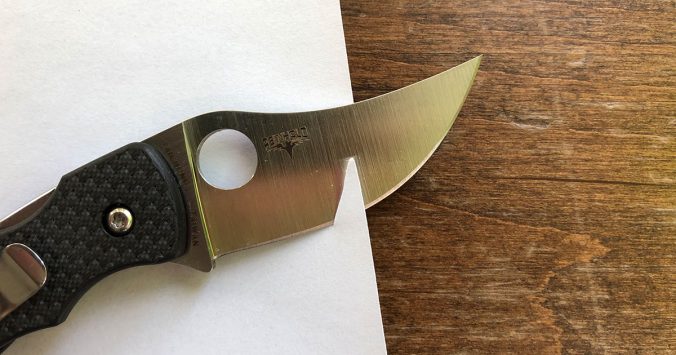This post has been updated since it was first posted in August 2012.
The vast majority of people can’t tell a dull knife from a sharp knife. People automatically assume that if a knife can cut, it’s sharp.
Unfortunately, that’s not always the case.
A dull knife will usually cut, but it requires much more force and energy than if you’re cutting with a truly sharp knife. So how can you tell if a knife is truly sharp? Here are a few ways to determine the sharpness of a blade.
Let us know your sharpness tests in the comments.
1. The Paper Test
Probably the most tried and true method is the good ol’ fashioned paper test. Grab a piece of paper, hold it between your fingers, and slide the knife downward. If it’s sharp, it will cleanly and easily slice the paper with just the weight of the knife. If it’s dull, it will usually be ragged or slip right off. This test also allows you to find any jagged or missed spots if you cut the whole length of the edge on a single stroke.
For an even better test of a blade’s sharpness, use a piece of magazine paper. Paper from a magazine is exceptionally thin and slick, which makes it even more difficult for a knife to slice through. According to Mike Vellekamp (who used to work at Spyderco before his current venture of V Nives), Sal Glesser used to make them use paper from National Geographic magazines. Phone book paper is an even tougher test, and toilet paper is the toughest.
Yet another variation fo the paper test is to fold the paper in half so it has a rounded edge. Cut the paper along the rounded edge and if it’s sharp, it will catch and cut the page.
Here’s a good clip from the legendary Bob Kramer on the paper test.
2. The Shaving Test
If you’ve ever watched knife reviews on YouTube, you’re probably familiar with the next test. It involves running the knife along your hair (usually your arm hair) and watching the little hairs get lopped off as the blade comes gliding through. Any hairs that fold under will indicate that the blade is not up to snuff.
Note that you shouldn’t have to touch the skin to get the hair to pop right off.
This is where the term “shaving sharp” comes from. Unfortunately, it can leave an awkward hairless patch on your arm. Not to mention the fact that you will eventually run out of arm hair to shave and may have to move on to other parts of your body. I’ll leave it up to your imagination.
3. Hair Whittling Test
For more advanced users, those who can actually split a piece of hair like the following person know they have a sharp blade on their hands.
When you can whittle a hair a few times, it’s even more impressive.
I’m not entirely sure about the real-world practicality of whittling hair sharp, but it looks so good and satisfying to see it performed.
4. The Tomato Test
Although the tomato test is usually aimed at kitchen knives, it’s actually a good test for any knife. All you have to do is get a tomato, rest the knife on top and pull back without applying pressure. If the knife slides through the tomato without any downward force, it’s sharp.
What makes the tomato such a ripe fruit for testing is that they are notoriously difficult to cut thanks to their tough flesh but soft insides. If you use a dull knife on a tomato, it will get crushed by the pressure. A sharp knife will be able to cut through the skin and insides without smashing the fruit. However, tomatoes do vary widely. Here’s a good demonstration in this YouTube video starting at 4:50.
An onion is another great food item to test sharpness on because the skin is so slippery that a dull knife will slide off while a sharp knife will dig right in.
5. Fingernail Test

A fingernail is a hard, protective covering made of alpha-keratin. It’s also a good option for testing the sharpness. People do this a few ways. A common method is to take the edge of the blade and rest it across your thumbnail. It should catch along the nail and not be able to move. You shouldn’t have to apply any pressure for the edge to catch on your nail. If it’s able to slide around, then it’s dull. It’s not always 100 percent accurate because a super sharp knife can still slip.
Another variation is to actually shave the calcium off your nail (or at least that’s what Vellekamp calls it). I just tried it with a sharp Kershaw Leek and it worked like a charm.
6. Three Finger Test
Murray Carter is a master Bladesmith who knows a thing or two about making knives. To test the sharpness of his blades, he uses something called the Three Finger Test. Here it is:
Wait, is he running his fingers along the sharpened edge of the knife? Yes. This method requires practice, knowledge, and careful consideration. By applying some light pressure on a sharpened blade without moving around, you can feel the sharpness of an edge without being bitten as we say in knife parlance.
You don’t slide your fingers unless the blade is dull and you only apply as much pressure as you feel your fingers can take. Mike Vellekamp does a variation where he places his thumb on the knife and tries to move it back and forth. If it catches and doesn’t move, he deems it sharp.
This test is controversial because of the potential danger, though with practice you can tell the different stages of knife sharpness. Some prefer a smoother edge than a toothier edge, so it may not catch as well.
There are nuanced discussions about the safety and effectiveness of this test over at BladeForums.
7. Visual Inspection

Image of a sharp edge from chefsteps.com
I was tempted to call this one the eye test, but that would be a misnomer since the naked eye can’t see all the complexities of a sharpened edge. To truly see whether an edge is sharpened, you need some help. People use various microscopes to look at the edge.
Using a microscope and sufficient lighting, you can actually see the fine details of the edge and see whether there is a burr or any imperfections. One of the best ways to visually see the sharpness of a blade is through a scanning electron microscope. These can go for several thousand dollars though.
Take a look at some blades observed through a scanning electron microscope here and here.
If you can’t afford to drop that much money, you can pick up a jewelers loupe for pretty cheap. When you use that with a light, you can get a better idea of the quality of your knife’s edge. More than anything you will be able to see imperfections in the edge like chips or rolls.
8. Tongue Test
Finally, there’s the old tongue test. Take a look at Vellekamp performing this little trick:
To be honest, I have no idea if this is an actual test or if he’s just messing with us. I have never tried this and have no intention of trying it because I would really know what I’m looking for and absolutely do not want to cut my tongue. Looking through Google and BladeForums only turned up some joking tongue sharpness tests. But if this is something you actually do, let me know in the comments.
Also, don’t try this at home.





January 16, 2019 at 5:49 pm
Recently through research and experience; I’ve found a great way to test blade sharpness and that is use pool noodles. I know for a fact that pool noodles are used in place of Japanese tatami mats when performing cutting tests with Japanese type blades; not to mention pool noodles are significantly cheaper than tatami mats; which get quite expensive. In fact pool noodles are quite cheap and abundant come spring time and especially during summertime. Pool noodles can be found really cheap at shops like Dollar Tree, 99 Cents and other similar shops. Through experience, I’ve used pool noodle to test a whole range of blade sizes from mini pocket knives to full length longswords. In conclusion; I suggest anyone and everybody to give pool noodle blade sharpness testing a try.
January 17, 2019 at 10:23 am
That’s really cool. I never thought of that. Just curious on how exactly you test the blades with the noodles. Do you try to slice through lengthwise or by shaving it?
December 25, 2019 at 5:18 am
For the “hair test”, I use my legs. That way, there is no bare patches on my arms.
December 25, 2019 at 10:54 am
I prefer not to cut anything and waste it, just to test a knife’s sharpness. It seems to me if the blade will not cut easily then you know it’s dulled and you use another one and sharpen the dulled one when you have time.
As far as testing, I think touching the edge gives us a pretty good idea of a blade’s condition, but to see if the knife cuts I test it on something I am going to toss in the recycling bin or try to slice and dice some fruit or veggies. Even if the cut is rough, you can cook or eat the food. I like to cut scrap cardboard, but sometimes it’s misleading because you cut through tape or you have a sharp spot, but the entire blade is not up to par. But when you run a knife through an onion or tomato, with the pulling and pushing action of slicing you know if you got the entire edge right or if it needs more work.
I also wouldn’t shave my nails as that could invite problems. Better to take a short swipe over one’s arm. An inch or two is enough. We don’t have to shave our legs, arms, heads and beards and look like some kind of newborn clone in a science fiction film… LOL.
October 23, 2021 at 6:53 pm
I prefer not to cut anything and waste it, just to test a knife’s sharpness. It seems to me if the blade will cut easily then you know it’s dulled and you use another one and sharpen the dulled one when you have time.
As far as testing, I think touching the edge gives us a pretty very good idea of a blade’s condition, but to see if the knife cuts I test it on something I am going to toss in the recycling bin or try to slice and dice some fruit or veggies. Even if the cut is rough, you can cook or eat the food. I like to cut scrap cardboard. But when you run a knife through an onion or tomato, with the pulling and pushing action of slicing you know if you got the entire edge right or if it needs more work.
October 23, 2021 at 6:58 pm
people who are looking to buy a good knife for a related cooking.the can go amazon and pick a very good knife after the revies.
October 23, 2021 at 7:00 pm
I really cool. I never thought of that. Just curious on how exactly you test the blades with the noodles. Do you try to slice through lengthwise or by shaving it?
November 29, 2021 at 9:29 pm
I cut hair of my left forearm to test test the blade. If an edge shave the hair easily like a shaving blade ..this is sharp.
February 18, 2022 at 11:04 am
Thank you! But you may not know that some of the video links are now dead.
January 11, 2023 at 11:46 am
More on paper test. Cutting copy paper the long way is easier. Cutting it along the short edge is harder, goes across the grain. A knife that easily cuts along the short edge of copy or note paper is really sharp.